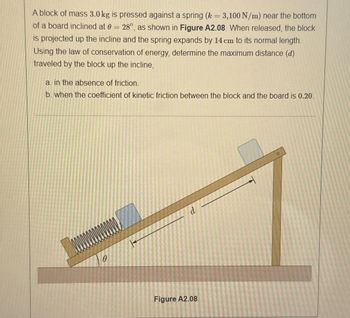Question

Transcribed Image Text:A block of mass 3.0 kg is pressed against a spring (k = 3,100 N/m) near the bottom
of a board inclined at = 28°, as shown in Figure A2.08. When released, the block
is projected up the incline and the spring expands by 14 cm to its normal length.
Using the law of conservation of energy, determine the maximum distance (d)
traveled by the block up the incline,
a. in the absence of friction.
b. when the coefficient of kinetic friction between the block and the board is 0.20.
0
Figure A2.08
d
Expert Solution
This question has been solved!
Explore an expertly crafted, step-by-step solution for a thorough understanding of key concepts.
This is a popular solution
Trending nowThis is a popular solution!
Step by stepSolved in 5 steps with 5 images

Knowledge Booster
Similar questions
- A 0.80 kg object tied to the end of a 2.0 m string swings as a pendulum. At the lowest point of its swing, the object has a kinetic energy of 10 J. Determine the speed of the object in m/s at the instant when the string makes an angle of 50° with the vertical. O 4.4 O 5.6 5.0 3.3 O6.1arrow_forwardA 13 kg runaway grocery cart runs into a spring with a spring constant of 260 N/mN/m and compresses it by 65 cm. What was the speed of the cart just before it hit the spring?arrow_forwardA 1.30 kg block slides on a frictionless horizontal surface until it encounters a spring with a force constant of 520 N/m. The block comes to rest after compressing the spring by the distance of 2.50 cm.What was the initial speed of the block ? O 0.25 m/s 5.0 m/s O 31.6 m/s O 0.50 m/sarrow_forward
- A block of mass m=1.2 kg is attached to a horizontal spring of force constant k=75 N/m. The block is pushed, and spring is compressed, to the position 10.0 cm to the left of the equilibrium position; then, block is released. A. Neglect friction. Find the speed of the block as it passes through the equilibrium position. B. If the friction is significant and µ = 0.22, what is the speed of the block as it passes through the equilibrium position? Please show the detailed solution, Thank youarrow_forwardA freight company uses a compressed spring to shoot 2.00 kgkg packages up a 1.00-mm -high frictionless ramp into a truck, as the figure(Figure 1) shows. The spring constant is 451 N/mN/m and the spring is compressed 31.0 cm. a.) What is the speed of the package when it reaches the truck? b.) A careless worker spills his soda on the ramp. This creates a 50.0-cmcm-long sticky spot with a coefficient of kinetic friction 0.300. Will the next package make it into the truck?arrow_forwardConsider the motion of a 1.00 kg particle that moves with potential energy given by U( x) = -(2.0 J∙m)/ x + (4.0 J∙m 2)/ x 2. Suppose the particle is moving with a speed of 30.00 cm/s when it is located at x = 3.00 m. What is th position with the greatest value of x at which the particle comes to rest? A.) 9.21 m B.)6.73 m c.) 5.48 m D.) 8.69 m E 7.29 marrow_forward
- 33. The spring constant of the spring below is 600 N/m. An object attached to it has a mass of 2.0 kg and is pulled 0.80 m to the right and released at time t=0. What is the first time (in milli-seconds) at which the kinetic energy is one-fourth the spring's potential energy? AGRO 2.0 kg x=0 600 N/m wwwwwwwwwwwwwwww *** 0 (a) 47.5 (b) 59.7 (c) 26.8 (d) 22.4 (e) none of these my 0.80 m 19.1arrow_forward1. A variable force f(x)= 3x² - 4x moves a particle from x1=1.0m to x2= 4.0m. Calculate the work done by the force. 2. A 5.0kg mass drops vertically from a height 4.0m on the plate on top of a spring balance whose force constant is 59N/m. By how much is the spring compressed?arrow_forwardA block with a mass of 2.0kg is held against a spring with a spring constant of 250 N/m. The block compresses the spring 22cm from its equilibrium position. After the block is released, it travels along a frictionless surface, then up a frictionless ramp. The ramps angle is 30.0 degrees. A) What is the stored elastic potential energy in the spring before it is released? B) What is the speed of the block as it travels along the surface? C) How far up the ramp will the block go?arrow_forward
arrow_back_ios
arrow_forward_ios